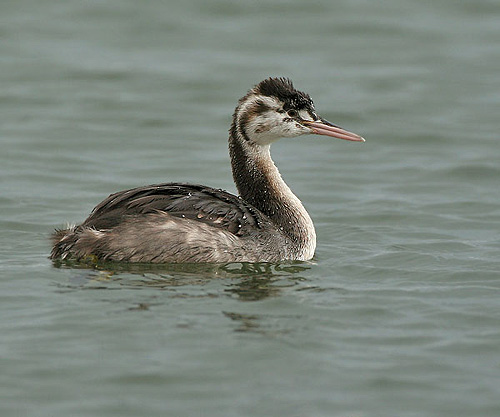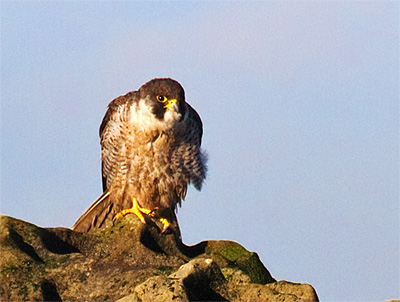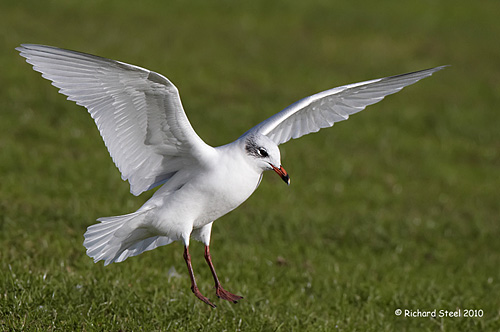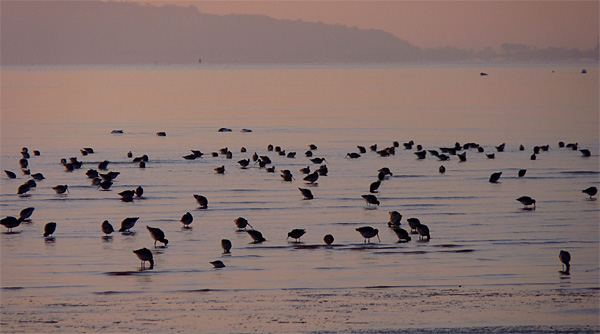Site menu:

December 2010 Newsletter
Great Crested Grebes - North Wirral.
North-East Wales Bird Report 2009.
November Bird News.
Forthcoming Events.
Latest Newsletter.
Great Crested Grebes off North Wirral

I remember well the day I discovered the North Wirral Great Crested Grebes. It was Nov 7th 2006, it was a nice sunny still day and I was high-tide wardening at West Kirby. As there were three of us on with very few birds to watch I decided I would be better employed at Hoylake where there had recently been some disturbance problems. Off I went to join the two wardens at Hoylake - there were more birds here but otherwise things were quiet. I had a quick look out to sea through my 'scope and saw a few Great Crested Grebes. After steep declines over the previous 10 years on both the Dee and Mersey estuaries any gathering of 10 or more was of interest so I thought I'd do a count on what was a fairly calm sea. There were over 20 at Hoylake but I could see more further east off towards Meols so got into my car and drove halfway to Dove Point to do another count. By the time I got to 120 I stopped to text my fellow wardens at West Kirby who were probably wondering where I was, and to tell them about my remarkable count. I completed my count at Dove Point reaching an amazing 378.

I realised straightaway that this was a high count by national standards, let alone locally. As soon as I got home I put the count on the latest sightings page but was a bit disappointed on finding out it wasn't a record high for Cheshire and Wirral, the highest being a count of 420 from Hilbre during September 1996. But that soon changed with a count of 458 on a mirror like sea on Feb 7th 2007. Over the following years there were many three-figure counts but none greater than 458 until October 2010 when a count of 546 on the 11th was followed by one of 604 on the 25th - at least ten times the typical high tide WeBS counts for the Dee estuary!
To put these counts into context the threshold for National Importance for this species is 159. They have been submitted to WeBS as supplementary counts and put the Dee estuary as the fourth most important site in the country (outside Ireland). The largest flocks are usually found in Dungeness and Rye Bay with a five year mean of 982. Larger flocks are found in Ireland with a five year mean of 1,692 in Belfast Lough.
Previous to these north Wirral counts the Dee estuary WeBS peaked in the 1990s with 246 between Parkgate and Greenfield on Oct 22nd 1993 followed by 205 in Sep 1996; but prior to this counts rarely exceeded 50, and after 1996 there has only been one count greater than 100. On the Mersey estuary there was a high count of 169 in 1996, prior to this counts were usually around the 100 mark but after 1996 numbers plummeted and this species now rarely exceeds double figures here, 2009 max count was nine. Can we then assume that the birds which were in the two estuaries in the 1990s now form the large flock off north Wirral? The short answer is no, we can't. It may well be the case but we just don't know and I suspect that the north Wirral flock has been there for a good number of years and that the 420 off Hilbre during Sep 1996 was in fact the same flock which just happened to have drifted further west, as did the 232 birds counted here on Mar 16th 2009.

Image produced from the Ordnance Survey Get-a-map service. Image reproduced with kind permission of Ordnance Survey.
You may wonder how such a large flock could have gone largely unnoticed before 2006, and how is it that no one else apart from myself sees these birds? It's not actually true I am the only one to see them, apart from the Hilbre counts mentioned above I know of at least four other birders who have had high counts between Hoylake and Leasowe, although it is true that the highest are mine. The reason for this is that at the distance these birds are, at least 2km/1.25 miles (see map), you need a virtually flat calm sea, good visibility, preferably with bright sunlight, and a high tide to see them at all, and even then you need a high quality telescope on full zoom (I have mine on x 60). Hardly any birders I know will bother to look out to sea in those conditions because the more exciting birds (skuas, petrels etc) only appear during strong winds - when the grebes are effectively invisible in the waves. The grebes are also well spread out, they don't tend to form tight flocks like Scoters, so only when a systematic search is carried out over a large area of sea will it be apparent the large numbers are out there.

Where do these birds come from? With its many Meres and Lakes Cheshire is an important breeding area for this species with an estimated 150 pairs, but many birds stay on these fresh water sites through the winter and there is no indication that the north Wirral wintering birds have a local origin. Of interest is the observation that during early January 2010, when nearly all the fresh water sites in Cheshire and elsewhere in the country were frozen over, there was no noticeable increase in numbers off north Wirral, which greatly surprised me at the time. This seems to confirm that these birds don't come from our local fresh water sites. On a European scale they are truly abundant with an estimate of at least 100,000 pairs breeding in north and west Europe. There are probably at least 40,000 pairs breeding in Scandinavia alone and the Lough Neagh area in Northern Ireland has around 4,000 pairs. Britain (outside Ireland) has 4,000 to 6,000 breeding pairs. The truth is that the migration patterns of Great Crested Grebes is poorly understood, and we just don't know where the birds which form large over-wintering flocks in this country go to breed - but it certainly seems likely that at least some are of Irish and/or Scandinavian origin.
UPDATE - 515 Great Crested Grebes counted from Hilbre by the Observatory on Dec 5th 2010 on a flat calm sea out towards Burbo Bank Windfarm, i.e. more or less in the same area as shown on the map.
Sources of Information:
1. Birds in Cheshire and Wirral (CAWOS Atlas), David Norman, 2008.
2. Waterbirds in the UK (WeBS Report), 2008/09.
3. Neil Friswell and Colin Wells, Dee Estuary WeBS Annual Report,
2008/2009.
4. BTO Migration Atlas, 2002.
5. Birds of the Western Palearctic (BWPi - interactive edition).
6. Waterbird Population Estimates, Fourth Edition, Simon Delany and Derek
Scott, 2006.
7. Local Birders who have sent me their counts.
8. Cheshire and Wirral Bird Reports 196 to 2009, CAWOS.
North-East Wales Bird Report 2009
 The North-East
Wales Bird Report 2009 is now available priced £5.00 from either Inner Marsh
Farm RSPB or Conwy RSPB. It can also be purchased from the Recorder - for
details see the Clwyd Bird Recording Group Website -
The North-East
Wales Bird Report 2009 is now available priced £5.00 from either Inner Marsh
Farm RSPB or Conwy RSPB. It can also be purchased from the Recorder - for
details see the Clwyd Bird Recording Group Website -
http://www.cbrg.org.uk/9Reports.html.
The website also has some sample pages from the report to look at.
Once again the CBRG have produced a fascinating and detailed report of the area's birds which were recorded in 2009. The report covers the area which used to be called Clwyd, i.e. the vice counties of Flintshire and Denbighshire, which includes the welsh side of the Dee estuary.
The majority of the species accounts have distribution maps so at a glance you can see where the main concentrations of birds are. There are a total of 21 colour photographs, including the front cover shot of a Buzzard by Barry Barnacal. The 148 pages include an update on the North Wales Breeding Atlas 2008-2011 and a 2009 review of the RSPB Conwy nature reserve. There is also a description of the little known Y Ddol Uchaf nature reserve, which has breeding Hawfinch among many other species, plus the usual ringing report - always a fascinating read. I would highly recommend this report to anyone with an interest in North-East Wales Birds.
Lastly - can I urge everyone to submit their records for inclusion in the North-East Wales Bird Reports - see http://www.cbrg.org.uk/5Submitrecords.html for details.
November Bird News

This could be a record breaking winter for Waxwings, we have still to get a good size flock sticking around but a total of 136 were reported through the month (some birds could have been counted twice) with birds being seen at Point of Ayr, Holywell, Hilbre, Thurstaston, Neston, West Kirby and along north Wirral - these included the first at Hilbre since 1961.
There are still a few Lapland Buntings around with single records from Inner Marsh Farm, Hilbre and Neston and two at Leasowe - I'd be surprised if there wasn't a small flock somewhere out on the marshes.
Hen Harriers built up nicely through the month with a total of six, perhaps seven, at the end including three grey males (one of which is a sub-adult). A Spoonbill was at Parkgate on the 1st. Out to sea there was another massive count of Great Crested Grebes - 526 on the 24th. 33 Eiders seen off Hilbre and north Wirral on the 22nd was a very high count for this area, there were good numbers throughout the month. Also off Hilbre were 25 Red-throated Divers, both Black-throated and Northern Divers and a Red-necked Grebe. There was quite a good number of Gannets in the mild southerly winds early in the month with max 34 on the 9th, earlier three late Leach's Petrel flew past on the 5th.
The cold weather at the end of the month brought large numbers of Black-tailed Godwits to Thurstaston shore, max 1,550 with about 18 colour-ringed birds. Max count of Dunlin was 10,000 at West Kirby and of Knot was 12,000 at Hoylake. Brent Geese reached 141 on the 25th.
Cockling along north Wirral still continues as I write this. It seems that North-west Fisheries did not consult Natural England before opening this bed, as implied in their reply to complaints - what the outcome of all this will be I have no idea but NE are currently undergoing an investigation. Thanks to everyone who did complain and pass on their concerns - I certainly get the impression that Natural England, North-west Fisheries and Wirral Borough Council were all very surprised at the very negative public reaction to the cockling and the large numbers of complaints.

Richard Smith.
What to expect in December
If the current cold spell continues we might well get a good influx of both waders and wildfowl coming in from North Sea coasts. A great place to see these is Thurstaston Shore, best about two to three hours before and after high tide - on a crisp cold sunny day this site can be truly spectacular.

On Hilbre Island both Brent Geese and Purple Sandpipers will increase, but a good place to see the latter is at New Brighton on the pontoon in the Marine Lake. In recent winters quite a sizeable flock of Pink-footed Geese have spent the winter on the marshes off Neston and Parkgate - expect to see up to 600 or so. Also on the marshes should be Hen Harriers and Short-eared Owls - although so far it has been a poor winter for this species.
With large numbers of Waxwings in the country sooner or later a sizeable flock is going to stick around for a few days in our area - I predict around Christmas time.
Forthcoming Events
December Highest Spring Tides (Liverpool)
Also see
Tides page.
24th December, 12.55hrs (BST), 9.5m.
Forthcoming Events
Organised by the
Wirral Ranger Service ,
Flintshire Countryside Service and/or the RSPB:
All these events and walks have bird interest, even those not advertised
specifically for birdwatching. No need to book for these events unless
specified - please check below.
Also see 2011 Events Diary.
Friday 3rd December, Hilbre Low Tide Walk.
Join the Rangers and the RSPB Wardens for a guided wildlife walk over the
sands to the Hilbre Island.
The walk across the sands and mud should produce a mix a waders whilst the
stay on the island is a good chance to get great views of the wintering
population of Brent Geese.
Wrap up warm and bring a packed lunch. Wellies and binoculars recommended
Booking essential, with a £2 charge.
Phone 0151 648 4371 to book a place.
Wednesday 8th December, 9.30am start, Estuary Watch:
Riverbank Road for Raptors
Join the Rangers & WCP Recording Group at Riverbank Road car park in Lower
Heswall for the second in a winter long series of bird watching events on
the internationally important Dee Estuary. As the mudflats & marsh floods
we hope to see many waders, ducks & raptors. High tide 12.27pm.
Please bring binoculars & warm waterproofs. No need to book.
Meet at Riverbank Road Car Park, Lower Heswall.
For further enquiries ring 0151 648 4371.
Sunday 12th December, Special RSPB Event to
to showcase bird cover crops and farmland
birds at Burton.
During the recent cold weather there were 40 yellowhammers
and 1000 linnets at Burton. RSPB are providing an opportunity for birders
to see this spectacle and
prove how important just a few acres of bird cover crop can be (see the
article in latest Birds Magazine).
Places are strictly limited to just 10 places (minimal disturbance to the
birds whilst they are obviously so desperate for food).
Phone 0151 336 7681 or email
paul.brady@rspb.org.uk to book.
Saturday 18th December - 12.30pm start, RSPB Burton Mere Walk.
This is for anybody wanting a free guided walk around Burton Mere and
"Inner Marsh Farm 2" to find out all about the reserve extension and
development.
Booking is essential so phone 0151 336 7681 to guarantee your place or to
get further details.
Sunday 19th December - 2.30pm start, Raptor Watch at
Parkgate Old Baths.
The RSPB Dee Estuary Nature Reserve is a vital wintering grounds for many
birds of prey – Discover these impressive birds in their wild habitat,
hunting before roosting on the saltmarsh. We can see up to 7 species of
birds of prey and 2 species of owl - so come along to find out more these
impressive hunters. Remember to bring your binoculars and dress
appropriately for the weather. For further enquiries call: 0151 336 7681.
Thursday 23rd December, 9am start, Estuary Watch: Christmas Special.
Heswall Shore is a wonderful place to watch the wading birds of the Dee
Estuary as the tide rises.
Join the Rangers & the WCP recording Group for a bird watch on the shore.
Please bring binoculars & warm waterproofs. For further enquiries ring 0151
648 4371.
Saturday, 1st January 9am-dusk, Inner Marsh
Farm Big Year.
What better way to start a big year for IMF than to have a go at a “Big
Year” and try to see as many species of birds as possible? You never know,
you could end up adding a new record to the impressive 230 birds already
seen on this part of the reserve. Raise money for conservation and have fun
- Get your checklist and see if you can you beat the RSPB staff?
Saturday 15th January - 12.30pm start, RSPB Burton Mere Walk.
This is for anybody wanting a free guided walk around Burton Mere and
"Inner Marsh Farm 2" to find out all about the reserve extension and
development.
Booking is essential so phone 0151 336 7681 to guarantee your place or to
get further details.
|
 |
The blank (UK) Birding Webring is a collection of quality birding web sites that are based in the United Kingdom. Visit the webring homepage for more information, or A complete list of all the sites in the webring is available by clicking here. previous site in ring : random site in ring : next site in ring |